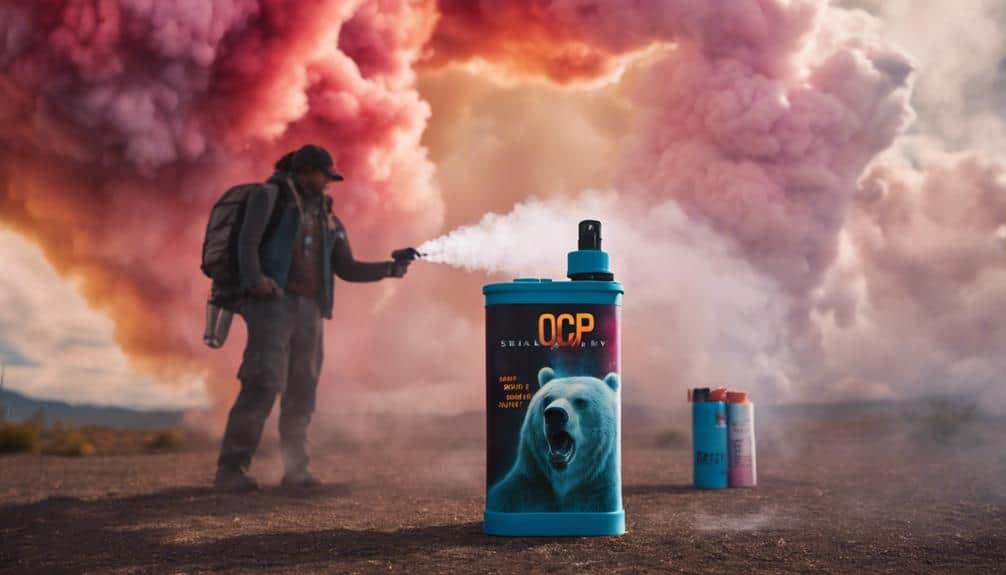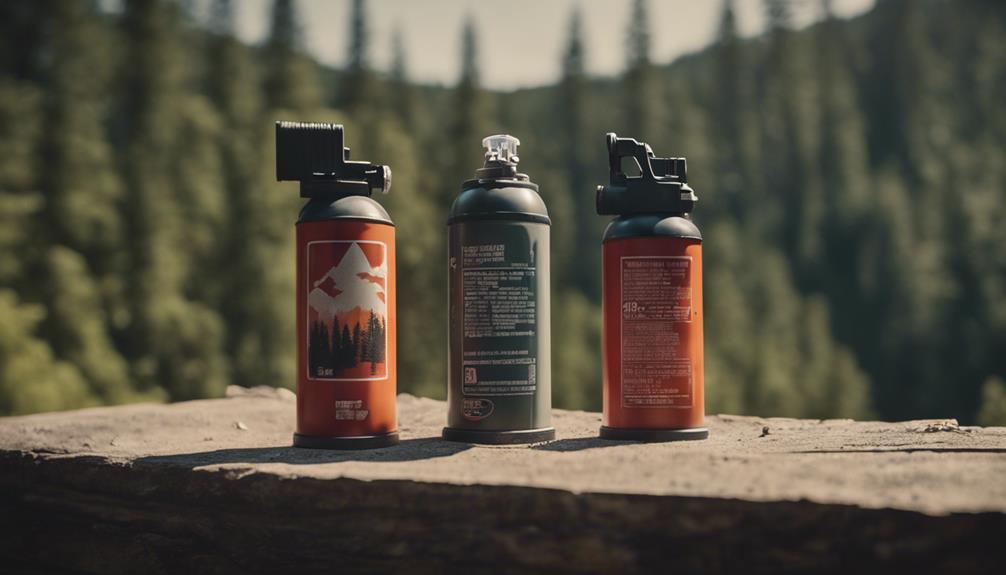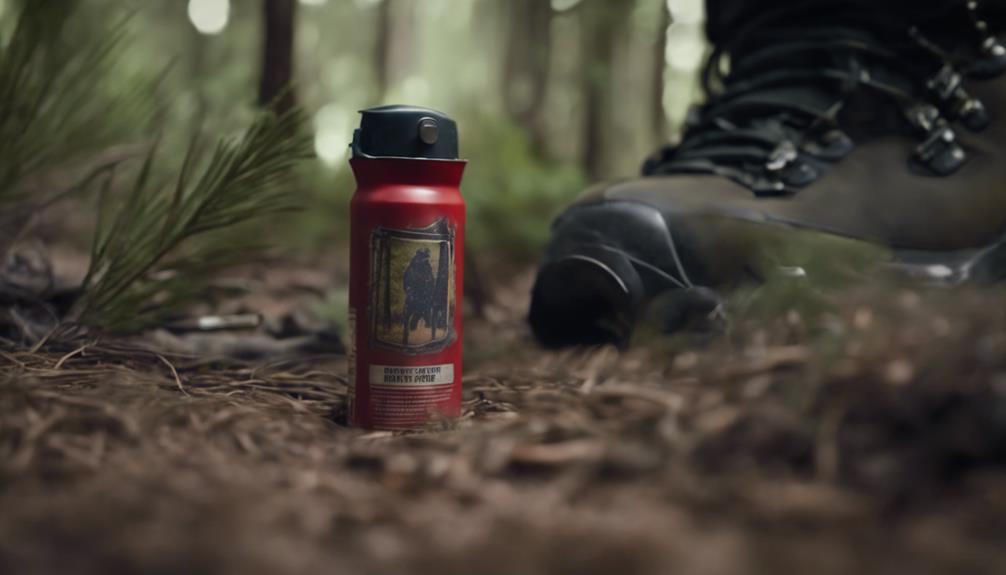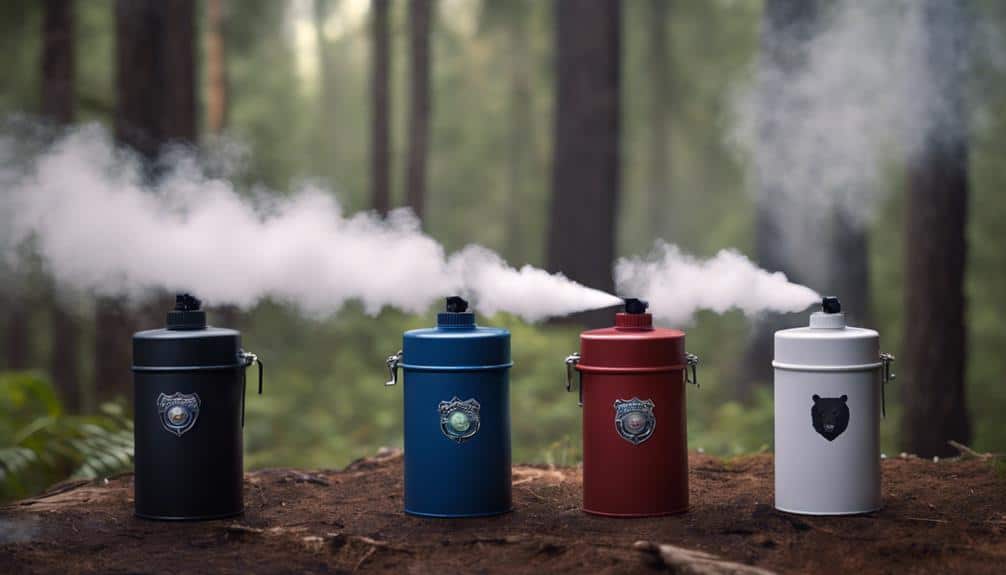Is OC Spray Stronger Than Bear Spray?
You’re probably wondering, is OC spray stronger than bear spray? Well, don’t grab the OC spray for a bear! Bear spray is way mightier, with a whopping 2% capsaicin concentration, while the fiercest OC spray tops out at 1.33%. Designed to stop a charging bear in its tracks, bear spray shoots a massive cloud up to 40 feet, giving you a protective barrier. On the flip side, OC spray is perfect for self-defense against human attackers, with a focused stream and about 10 feet of range. Curious about when to use each and other cool details? You’ll definitely want to stick around!
 When comparing strength and composition, bear spray outmatches standard pepper spray with its 2% capsaicin concentration.
This might surprise you, but bear spray isn’t just a beefed-up version of pepper spray—it’s a whole different beast. Bear spray’s 2% capsaicin and related capsaicinoids pack a punch that’s meant to stop a charging bear in its tracks.
In contrast, even the strongest pepper spray on the market only reaches a maximum of 1.33% capsaicin concentration, and most everyday pepper sprays have less than 1%.
Now, you might be thinking, ‘How big of a difference can that extra percentage make?’ Well, it’s huge. That extra capsaicin means bear spray is about 50% stronger than the toughest pepper spray you can find.
Bear spray is formulated specifically to deter large animals, so it’s got some extra ingredients to maximize its strength and effectiveness. These added ingredients enhance its deterrent properties, making it a formidable tool in the wild.
When comparing strength and composition, bear spray outmatches standard pepper spray with its 2% capsaicin concentration.
This might surprise you, but bear spray isn’t just a beefed-up version of pepper spray—it’s a whole different beast. Bear spray’s 2% capsaicin and related capsaicinoids pack a punch that’s meant to stop a charging bear in its tracks.
In contrast, even the strongest pepper spray on the market only reaches a maximum of 1.33% capsaicin concentration, and most everyday pepper sprays have less than 1%.
Now, you might be thinking, ‘How big of a difference can that extra percentage make?’ Well, it’s huge. That extra capsaicin means bear spray is about 50% stronger than the toughest pepper spray you can find.
Bear spray is formulated specifically to deter large animals, so it’s got some extra ingredients to maximize its strength and effectiveness. These added ingredients enhance its deterrent properties, making it a formidable tool in the wild.
 While bear spray‘s range and coverage make it a formidable tool in the wild, understanding its regulation and safety standards is equally important. Bear spray is more highly regulated by the Environmental Protection Agency (EPA) to guarantee it’s both effective and humane. These regulations aren’t just random rules—they’re designed to protect both you and the wildlife.
You might think pepper spray follows the same strict guidelines, but that’s not the case. Regulations for bear spray include rigorous testing standards. The EPA mandates that bear spray must have at least 2% capsaicin and related capsaicinoids to be effective. Pepper spray, on the other hand, can have lower concentrations and different formulations, making its effectiveness less predictable.
Safety measures for bear spray are strict to prevent misuse. If you’re thinking of using bear spray on a person, think again! That could land you in serious legal trouble. These rules are there to keep everyone safe and guarantee the spray is used correctly.
While bear spray‘s range and coverage make it a formidable tool in the wild, understanding its regulation and safety standards is equally important. Bear spray is more highly regulated by the Environmental Protection Agency (EPA) to guarantee it’s both effective and humane. These regulations aren’t just random rules—they’re designed to protect both you and the wildlife.
You might think pepper spray follows the same strict guidelines, but that’s not the case. Regulations for bear spray include rigorous testing standards. The EPA mandates that bear spray must have at least 2% capsaicin and related capsaicinoids to be effective. Pepper spray, on the other hand, can have lower concentrations and different formulations, making its effectiveness less predictable.
Safety measures for bear spray are strict to prevent misuse. If you’re thinking of using bear spray on a person, think again! That could land you in serious legal trouble. These rules are there to keep everyone safe and guarantee the spray is used correctly.
When you’re hiking or camping, bear spray’s wide dispersal method covers a larger area, giving you a better chance of deterring unpredictable wildlife. Meanwhile, pepper spray’s targeted stream is perfect for urban self-defense, allowing precise application when needed. Remember, bear spray is EPA-approved specifically for bears, meaning it’s more regulated, whereas pepper spray’s rules are generally looser, reflecting its common use in populated areas. So, pack accordingly, and stay safe out there!
 When thinking about environmental impact, you’ve got to contemplate how bear spray and OC spray affect the world around you.
Bear spray, with its broad fog, might seem like overkill in a crowded park, while OC spray’s targeted burst is more urban-friendly.
But hey, don’t forget to check the rules—using bear spray in the city might get you more than just odd looks!
When thinking about environmental impact, you’ve got to contemplate how bear spray and OC spray affect the world around you.
Bear spray, with its broad fog, might seem like overkill in a crowded park, while OC spray’s targeted burst is more urban-friendly.
But hey, don’t forget to check the rules—using bear spray in the city might get you more than just odd looks!
 You might think all sprays are the same, but they’re not.
Bear spray packs a bigger punch with up to 2% capsaicin and can reach up to 40 feet to create a massive cloud, while OC spray is more focused and meant for close encounters, only going up to 12 feet.
Each is crafted for specific situations—one for big, furry bears and the other for those unexpected human threats.
You might think all sprays are the same, but they’re not.
Bear spray packs a bigger punch with up to 2% capsaicin and can reach up to 40 feet to create a massive cloud, while OC spray is more focused and meant for close encounters, only going up to 12 feet.
Each is crafted for specific situations—one for big, furry bears and the other for those unexpected human threats.
 Understanding the differences between OC spray and bear spray bolsters your confidence in choosing the right product for any situation.
Bear spray is designed with a 2% capsaicin concentration to stop a charging bear in its tracks, while the strength of pepper spray, or OC spray, usually hovers below 1.33%. This makes OC spray less effective against wildlife but more suited for self-defense against humans.
Knowing that bear spray is regulated by the EPA means it meets rigorous safety standards. You can trust that it’s humane and effective, giving you peace of mind. Imagine hiking through the wilderness, confident that your bear spray will work if you encounter a bear. That’s a pretty good feeling, right?
Proper training in using both sprays is essential. You don’t want to fumble around in a panic. A bit of practice guarantees you’re prepared, boosting your personal safety and confidence in its effectiveness. Picture yourself confidently handling a potentially scary situation because you know exactly what to do.
Ultimately, carrying the correct spray for your environment, whether it’s a crowded city or the great outdoors, is crucial. It’s all about guaranteeing your safety and enjoying peace of mind, no matter where you are.
Understanding the differences between OC spray and bear spray bolsters your confidence in choosing the right product for any situation.
Bear spray is designed with a 2% capsaicin concentration to stop a charging bear in its tracks, while the strength of pepper spray, or OC spray, usually hovers below 1.33%. This makes OC spray less effective against wildlife but more suited for self-defense against humans.
Knowing that bear spray is regulated by the EPA means it meets rigorous safety standards. You can trust that it’s humane and effective, giving you peace of mind. Imagine hiking through the wilderness, confident that your bear spray will work if you encounter a bear. That’s a pretty good feeling, right?
Proper training in using both sprays is essential. You don’t want to fumble around in a panic. A bit of practice guarantees you’re prepared, boosting your personal safety and confidence in its effectiveness. Picture yourself confidently handling a potentially scary situation because you know exactly what to do.
Ultimately, carrying the correct spray for your environment, whether it’s a crowded city or the great outdoors, is crucial. It’s all about guaranteeing your safety and enjoying peace of mind, no matter where you are.
Strength and Composition

Range and Coverage
Bear spray offers a significant advantage over pepper spray with its impressive range of 20 to 40 feet. Imagine you’re out in the wild, and a bear starts approaching. You need something that keeps you safe from a distance, right? That’s where bear spray shines. Its effective range allows you to create a safety bubble around yourself, giving you precious seconds to act. Pepper spray, on the other hand, has a much shorter effective range, usually around 10 feet. This means you’ve got to be pretty close to your threat, which isn’t ideal when you’re facing off with an angry bear or even an aggressive person. The difference in range can be a game-changer in critical situations. Bear spray also excels in coverage. When you deploy bear spray, it disperses in a cloud, covering a larger area. This wider dispersal means you don’t have to aim with pinpoint accuracy. In contrast, pepper spray shoots out in a narrow stream, requiring more precise aim. Environmental factors, like wind, can affect both sprays, but bear spray’s broader coverage gives you a better shot at hitting the target and staying safe. So, when it comes to range and coverage, bear spray is clearly the heavyweight champ.Regulation and Safety

Usage Context
When you’re out in the wild, bear spray can be your best friend, making sure those huge, scary bears keep their distance. On the other hand, OC spray is your go-to in the city, ready to protect you from human threats with just a quick spritz. Knowing how to use each one properly is essential, so you don’t end up in a sticky situation, literally and figuratively!Wilderness Vs. Urban Environments
Maneuvering wilderness and urban environments requires understanding the distinct purposes and functionalities of OC spray and bear spray. In the wilderness, bear spray is your best friend for keeping bears at bay. It has a long effective range, up to 40 feet, so you can deter a bear before it gets too close. In contrast, OC spray, or pepper spray, is designed for self-defense in urban environments. It has a shorter range, about 10 feet, making it ideal for close encounters with human threats. Here’s a quick comparison to help you get a grip on the differences:| Feature | Bear Spray | Pepper Spray |
|---|---|---|
| Effective Range | Up to 40 feet | Around 10 feet |
| Usage Context | Wilderness | Urban Environments |
| Dispersal Method | Wide Cloud | Targeted Stream |
Proper Spray Deployment Techniques
Understanding the differences between bear spray and pepper spray is essential, but knowing how to deploy them properly can make all the difference in a critical moment. Envision this: you’re hiking, and suddenly, a bear charges at you. With bear spray, you’ve got to aim slightly downward because the spray’s trajectory will naturally go upward. This way, you’ll hit the bear’s face effectively. When the bear is within 30 feet, deploy the canister and spray in a sweeping motion, standing your ground to create a barrier. Now, let’s switch gears to pepper spray for self-defense in an urban setting. Suppose someone’s attacking you. You need to aim for their face, specifically targeting their eyes and respiratory area. This will maximize incapacitation, giving you the best chance to escape. Remember, practice makes perfect. Spend some time in a controlled setting to get comfortable with the deployment techniques for both types of spray. Whether you’re fending off a bear or an attacker, proper deployment, aiming, and understanding the range of your spray can be lifesaving. Don’t wait until you’re in a dire situation to figure it out—practice now and be prepared.Additional Considerations

Environmental Impact
While both bear spray and OC spray serve essential purposes, their environmental impacts differ significantly. Bear spray, which contains oleoresin capsicum, is formulated to be humane and effective against wildlife without causing long-term harm. It’s subject to EPA regulations, ensuring that its ingredients are safe for the environment and don’t negatively affect non-target species. When you use bear spray, it disperses in a cloud form, temporarily alarming wildlife but dissipating quickly without leaving harmful residues. This makes it kinder to ecosystems. On the flip side, OC spray, often used for self-defense, might not have such stringent environmental regulations. This raises concerns about its potential effects on soil and water quality if you don’t dispose of it properly. Proper disposal and usage are critical to minimizing their ecological footprint, especially in sensitive habitats. Here’s a quick comparison to make things clearer:| Aspect | Bear Spray | OC Spray |
|---|---|---|
| Formulation | Humane, designed for wildlife | Designed for self-defense |
| Regulations | Strict EPA regulations | Less stringent regulations |
| Dispersal | Cloud form, dissipates quickly | Varies, may not dissipate as quickly |
| Impact on Ecosystems | Temporary, minimal long-term effects | Potentially harmful if not disposed of properly |
| Usage | Effective and safe for wilderness areas | Effective but requires careful disposal |
Usage Guidelines
Knowing the correct usage guidelines for both bear spray and OC spray guarantees you maximize their effectiveness and safety. Bear spray, specifically formulated for deterring large animals like bears, has a much higher capsaicin content than pepper spray, making it stronger. But don’t think you can use it on people! It’s got a range of up to 40 feet, creating a wide cloud to stop a charging bear in its tracks. Imagine being on a hike, and suddenly, a bear appears. You’d definitely want that extra distance and coverage to ascertain your safety. Pepper spray, on the other hand, is designed for self-defense against human threats. With a range of about 10 feet, it shoots a targeted stream to quickly incapacitate an attacker. Picture yourself walking alone at night, and someone approaches you aggressively. OC spray’s compact, focused stream is perfect for that scenario, hitting the target right where you need it.Effectiveness in Different Situations
In different situations, bear spray‘s broader coverage and higher capsaicin concentration make it more effective against wildlife, while OC spray is better suited for self-defense against human threats. Picture yourself hiking through the woods, enjoying the serenity, when suddenly, a massive bear appears. Yikes! In this scenario, bear spray is your best friend. With its higher concentration of capsaicin and wider dispersal, it creates a cloud that deters bears effectively. It’s like throwing a spicy smoke bomb—those physiological effects, like swelling and panic, are no joke for bears. The effectiveness of bear spray is impressive, boasting a 90-98% success rate. It’s designed to keep you safe in the wild, ensuring a hasty retreat for any curious or aggressive wildlife. Now, think about walking home late at night when someone shady starts following you. That’s where OC spray, commonly known as pepper spray, shines. It’s got a more targeted stream, perfect for hitting the mark with a human attacker. Its physiological effects cause temporary incapacitation, giving you precious time to escape. While its capsaicin concentration might be lower than bear spray, don’t underestimate its power as a deterrent. Pepper spray is incredibly effective in these close-quarter, high-stress situations. In short, the right spray for the right situation can mean the difference between safety and danger.Differences Between Sprays

Potency and Concentration
Bear spray packs a more potent punch than OC spray due to its higher concentration of capsaicin and related capsaicinoids. Bear spray contains a maximum concentration of 2%, which is considerably stronger than most OC sprays that typically cap off at around 1.33%. This difference in the concentration of the active ingredient, oleoresin capsicum, makes bear spray about 50% stronger than SABRE Pepper spray. Now, you might wonder why this matters. Well, the strength of these sprays is measured by their Major Capsaicinoids level. Wildfire pepper sprays, for instance, have 1.33% Major Capsaicinoids, while bear spray boasts a whopping 2.0%. That’s quite a jump! Fundamentally, bear spray is designed to stop a bear in its tracks, so it needs to be much more potent than the sprays meant for human attackers. Pepper sprays, like those little cans you carry on your keychain, are meant to give you a chance to escape a bad situation. But when you’re out in bear country, you need something with serious stopping power. That’s where bear spray’s higher concentration and extra kick come in handy.Intended Use Cases
When choosing between OC spray and bear spray, it’s crucial to contemplate their specific intended use cases. Pepper spray is your go-to for self-defense against human attackers. It’s designed to incapacitate someone quickly, giving you time to escape. Bear spray, on the other hand, is your wilderness buddy, formulated to deter bears and other large animals. Now, let’s talk concentration! Bear spray contains up to 2% capsaicin, making it way more potent for those big, furry threats. Pepper spray, with a max concentration of about 1.33%, focuses on stopping humans. The effective range is also a game-changer. Bear spray can reach up to 40 feet, giving you a buffer zone, while pepper spray only goes about 10 feet, which is perfect for close encounters. Bear spray spreads out in a wide cloud, covering a larger area to ward off a charging bear. Meanwhile, pepper spray shoots a targeted stream aimed at the attacker’s face. Legal stuff? Bear spray’s approved for wildlife, and pepper sprays for personal protection. So, think about where and why you might need these sprays before deciding which one to carry.Legal Considerations
Maneuvering through the legal landscape of OC spray and bear spray requires a clear understanding of their distinct regulations and permissible uses. When it comes to pepper spray, legal considerations vary widely. In some places, you can carry it without a problem, while others have strict legal restrictions on its use and strength. Knowing the rules in your area is vital. Bear spray, on the other hand, has its own set of regulations. It’s expressly designed for wildlife encounters and must meet EPA standards to guarantee it’s humane and effective. Using bear spray on humans? That’s a big no-no and can lead to significant legal trouble, including criminal charges or hefty fines. Misusing bear spray isn’t just dangerous; it’s irresponsible. To help you navigate these waters, let’s break it down:- Pepper spray laws: Different states, different rules.
- Bear spray regulations: Stricter, EPA-controlled.
- Misuse penalties: Legal repercussions for using bear spray on people.
- Responsible ownership: Know the rules, use them wisely.
Safety and Confidence

Recommended Use Cases
Choosing the right spray for your environment guarantees you’re prepared for any situation, whether it’s hiking through bear country or traversing city streets. Bear spray and pepper spray each have their own unique uses and understanding them can make all the difference. Bear spray is specifically designed for deterring bears in the wilderness. Its 2% capsaicin formula and effective range of up to 40 feet make it a reliable choice when you’re camping or hiking in bear habitats. Fundamentally, it creates a protective barrier, giving you an essential safety net against potentially dangerous wildlife. On the other hand, OC spray, commonly known as pepper spray, is designed for personal safety in urban settings. With a range of about 10 feet, it’s perfect for self-defense against human threats. Spraying it in someone’s face can provide the few seconds you need to escape a dangerous situation. Here’s a quick breakdown:- Bear spray:
- Deterring bears
- Up to 40 feet range
- Larger coverage area
- Pepper spray (OC spray):
- Self-defense in urban areas
- Around 10 feet range
Frequently Asked Questions
How Much OC Is in Bear Spray?
Bear spray contains OC concentration levels up to 2%, making it highly effective. Its application methods and effectiveness differ from standard OC sprays. Legal regulations guarantee its safety and potency, with active ingredients designed for deterring large animals.How Powerful Is OC Spray?
OC spray’s effects on humans are potent due to its capsaicin ingredients. When using OC spray, guarantee you understand its regulations and safety guidelines. Consider alternatives if needed, but know it’s effective for self-defense.Will OC Spray Work on a Bear?
OC spray won’t work effectively on a bear. For wildlife safety and personal protection during animal encounters, rely on bear spray. It’s specifically designed for defensive measures, ensuring better spray effectiveness in deterring aggressive bear behavior.What Is OC Spray Comparable To?
OC spray, or pepper spray, is comparable to other self-defense options due to its effectiveness in close-range encounters. When analyzing chemical composition, spray range differences, and personal safety tools, it stands out among various animal deterrents.
Facebook
Twitter
LinkedIn
Pinterest
Tagged Bear Spray, OC Spray, Pepper Spray


One Response